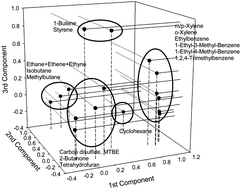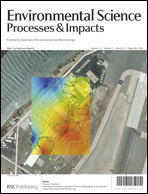Emissions of volatile organic compounds (VOCs), particularly those from industrial sources, have been of substantial concern because they have had adverse effects on the nearby environment and human health. In this study, the effect of altitude on the distributions of VOCs from petrochemical industrial sources was studied by analyzing the VOC concentrations at ground level and three different altitudes (100, 300, and 500 m above the ground) during three monitoring seasons from 2009 to 2010 and assessing the results by principal component analysis (PCA) and cluster analysis. Kaohsiung city in southern Taiwan, known for its high levels of air contaminants due to many pollution-intensive industries in the city, was selected as the area to be examined. Of various types of aliphatic and aromatic hydrocarbons being detected, acetone and toluene were the dominant VOC species with relatively high concentrations. By PCA application and cluster analysis, aromatic and aliphatic compounds were found to be the main VOCs accounting for the maximum variance of the data observed at ground level and high altitude, respectively. The presence of mono-aromatic hydrocarbons at ground level suggested an important contribution from traffic, while the presence of both saturated and unsaturated hydrocarbons at high altitudes was likely to be due to the local petrochemical industries given the heights of flare stacks in the examined areas and short lifetimes of unsaturated hydrocarbons such as alkenes. 3-D loading plots exhibited clear grouping of the VOCs in terms of their chemical structures and/or physicochemical characteristics for the data at ground level and 500 m and less clear differentiation for the data at 100 and 300 m, possibly resulted by atmospheric dispersion and mixing. The influence of altitude on the VOC distributions appeared not to be negligible and was greatly impacted by the location (e.g., height) of emission sources and the physicochemical properties of the VOCs including their molecular weights/sizes and lifetimes in the atmosphere. These findings prove the complications in the current knowledge of VOC pollution and are of help in managing the adverse impacts on the environment and public health by VOCs from industrial or other sources.

You have access to this article
 Please wait while we load your content...
Something went wrong. Try again?
Please wait while we load your content...
Something went wrong. Try again?


 Please wait while we load your content...
Please wait while we load your content...